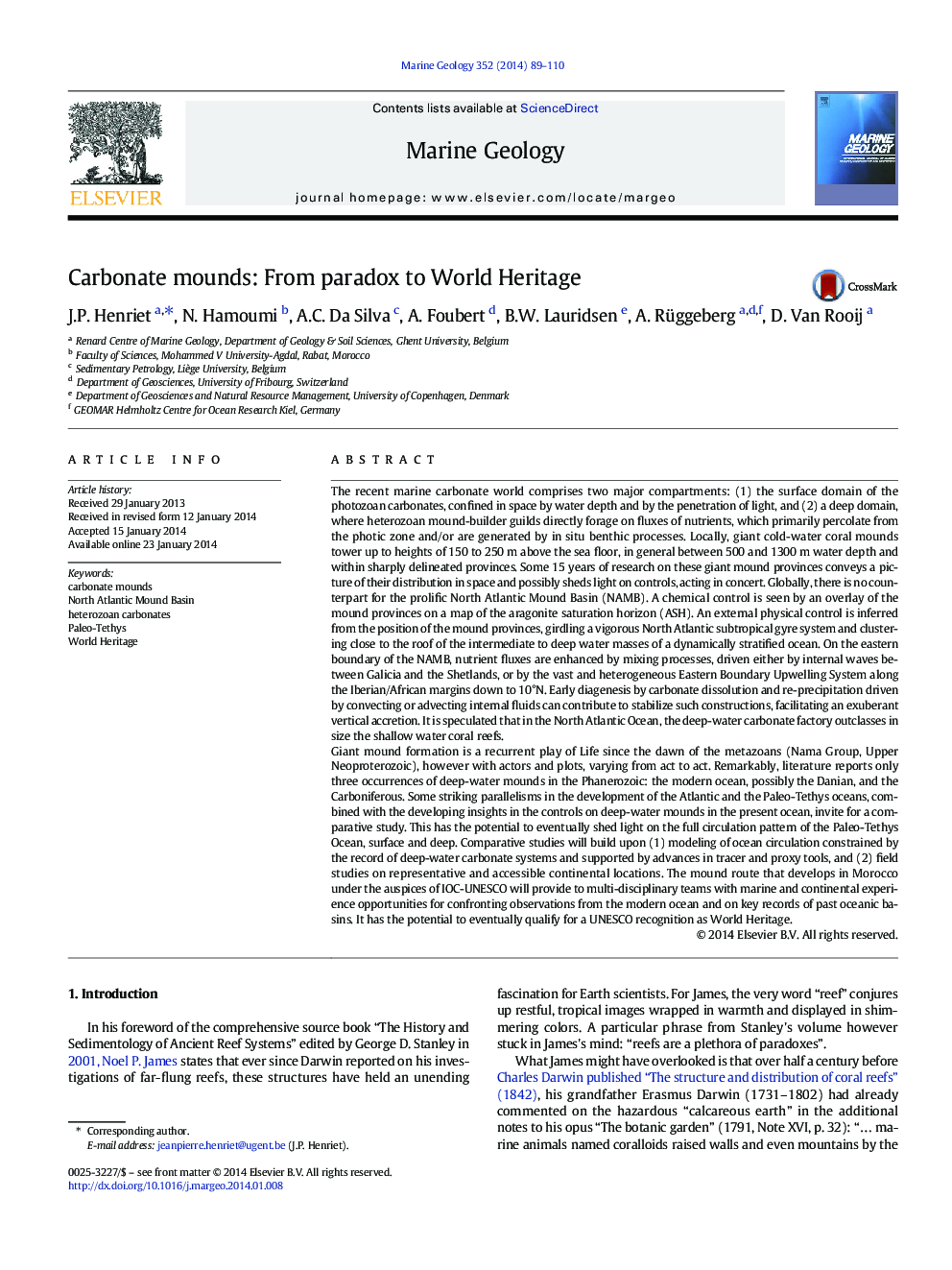| کد مقاله | کد نشریه | سال انتشار | مقاله انگلیسی | نسخه تمام متن |
|---|---|---|---|---|
| 6441661 | 1639100 | 2014 | 22 صفحه PDF | دانلود رایگان |
- The North Atlantic cold-water coral Mound Basin (NAMB) is unique.
- E. Atlantic mounds cluster close to the roof of the intermediate water masses.
- Carbonate mounds may open a window on past intermediate to deep ocean circulation.
- There are striking analogies between the Recent Atlantic and the Paleo-Tethys.
- Comparative studies will benefit of a reference mound route in Morocco.
The recent marine carbonate world comprises two major compartments: (1) the surface domain of the photozoan carbonates, confined in space by water depth and by the penetration of light, and (2) a deep domain, where heterozoan mound-builder guilds directly forage on fluxes of nutrients, which primarily percolate from the photic zone and/or are generated by in situ benthic processes. Locally, giant cold-water coral mounds tower up to heights of 150 to 250 m above the sea floor, in general between 500 and 1300 m water depth and within sharply delineated provinces. Some 15 years of research on these giant mound provinces conveys a picture of their distribution in space and possibly sheds light on controls, acting in concert. Globally, there is no counterpart for the prolific North Atlantic Mound Basin (NAMB). A chemical control is seen by an overlay of the mound provinces on a map of the aragonite saturation horizon (ASH). An external physical control is inferred from the position of the mound provinces, girdling a vigorous North Atlantic subtropical gyre system and clustering close to the roof of the intermediate to deep water masses of a dynamically stratified ocean. On the eastern boundary of the NAMB, nutrient fluxes are enhanced by mixing processes, driven either by internal waves between Galicia and the Shetlands, or by the vast and heterogeneous Eastern Boundary Upwelling System along the Iberian/African margins down to 10°N. Early diagenesis by carbonate dissolution and re-precipitation driven by convecting or advecting internal fluids can contribute to stabilize such constructions, facilitating an exuberant vertical accretion. It is speculated that in the North Atlantic Ocean, the deep-water carbonate factory outclasses in size the shallow water coral reefs.Giant mound formation is a recurrent play of Life since the dawn of the metazoans (Nama Group, Upper Neoproterozoic), however with actors and plots, varying from act to act. Remarkably, literature reports only three occurrences of deep-water mounds in the Phanerozoic: the modern ocean, possibly the Danian, and the Carboniferous. Some striking parallelisms in the development of the Atlantic and the Paleo-Tethys oceans, combined with the developing insights in the controls on deep-water mounds in the present ocean, invite for a comparative study. This has the potential to eventually shed light on the full circulation pattern of the Paleo-Tethys Ocean, surface and deep. Comparative studies will build upon (1) modeling of ocean circulation constrained by the record of deep-water carbonate systems and supported by advances in tracer and proxy tools, and (2) field studies on representative and accessible continental locations. The mound route that develops in Morocco under the auspices of IOC-UNESCO will provide to multi-disciplinary teams with marine and continental experience opportunities for confronting observations from the modern ocean and on key records of past oceanic basins. It has the potential to eventually qualify for a UNESCO recognition as World Heritage.
Journal: Marine Geology - Volume 352, 1 June 2014, Pages 89-110
